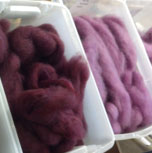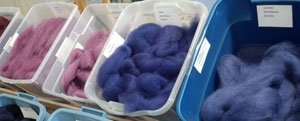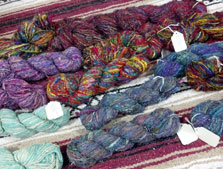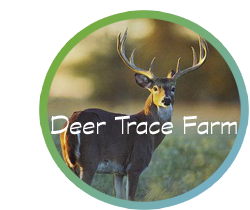Speciality Fibers

During the warm months of the year Carole Runyon mainly washes and dyes new fleeces. On a dyeing day, the deck outside the studio is covered with vats of bubbling dyes and heaps of raw and new-dyed wool. "The deck will be covered with mounds of clouds," she says.
Runyon dyes wool into families of colors before spinning it into yarn. That way a thread of her blue yarn, on closer look, contains a range of blues from pale to midnight. "Aren't those colors just too scrumptious?" Runyon asks, looking into a bag of blue-to-green wool. "I use a variety of related colors so that my yarn kind of has a glow to it."

Carole Runyon delights in going through the stages of fabric making. The raw fur, from rabbits or sheep, is carded into smooth bits of fluff. Runyon takes the fluff, combed into long strands, and spins it by starting one twisted end onto the spindle and then stretching and smoothing the fluff as the action of the spinning twists it into a ply of yarn. Then the plies are twisted together to make yarn.

For spinning, Carole uses the same type of drop spindle spinners used worldwide in prehistoric times. The spindle looks like a toy top, which she spins and drops as she stretches and smooths the fluff. Then she winds the new strand onto the spindle, secures the top with a half hitch, and spins another few feet of thread.
For museum demonstrations, she uses the classic high wheel, also called a walking wheel. The tall spinning wheel, set into a slanted base, spins a slim spindle as she smooths the fibers, walking backwards as the thread grows out of her hands.
Note: Text was drawn from an article in The Huntsville Times, 6/21/04, by Kay Campbell, but material was updated.
